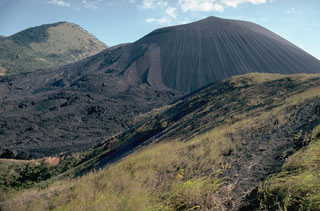Report on Cerro Negro (Nicaragua) — 5 June-11 June 2013
Smithsonian Institution / US Geological Survey
Weekly Volcanic Activity Report, 5 June-11 June 2013
Managing Editor: Sally Sennert.
Please cite this report as:
Global Volcanism Program, 2013. Report on Cerro Negro (Nicaragua) (Sennert, S, ed.). Weekly Volcanic Activity Report, 5 June-11 June 2013. Smithsonian Institution and US Geological Survey.
Cerro Negro
Nicaragua
12.506°N, 86.702°W; summit elev. 728 m
All times are local (unless otherwise noted)
INETER reported that the seismic station at the base of Cerro Negro recorded the onset of tremor at 0845 on 4 June. Seismicity fluctuated; Real-time Seismic Amplitude Measurement (RSAM) values increased to 60 units, from an average value of 14. From 1535 to 1731 the network recorded 49 earthquakes that were too small to be located.
Geological Summary. Nicaragua's youngest volcano, Cerro Negro, was created following an eruption that began in April 1850 about 2 km NW of the summit of Las Pilas volcano. It is the largest, southernmost, and most recent of a group of four youthful cinder cones constructed along a NNW-SSE-trending line in the central Marrabios Range. Strombolian-to-subplinian eruptions at intervals of a few years to several decades have constructed a roughly 250-m-high basaltic cone and an associated lava field constrained by topography to extend primarily NE and SW. Cone and crater morphology have varied significantly during its short eruptive history. Although it lies in a relatively unpopulated area, occasional heavy ashfalls have damaged crops and buildings.
Source: Instituto Nicaragüense de Estudios Territoriales (INETER)

